|
Chapter Three Minifig Weapons  Players are free to invent all kinds of unique minifig items in addition to the generic weapon types. Who knows what mysterious powers this Skully Grail might possess?
own illustration
own illustration Uploaded, final
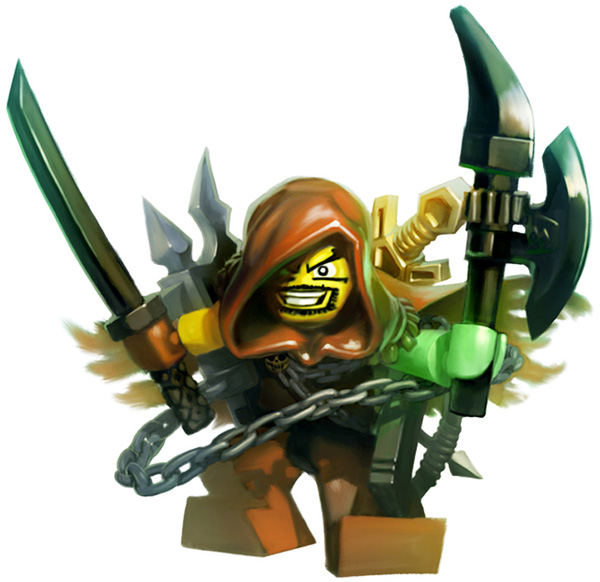
With the logic-defying ability to wield an unlimited number of weapons simultaneously, the semi-mythical hero Zahru Trollarm brought the human minifigs of Medivo back from the brink of extinction in ancient times, slaying his way through hordes of Dungans, trolls, and the undead forces of the evil spirit Warhead.
Wiki entry: Zahru Trollarm
own illustration Uploaded, final
The weapons a player arms their minifigs with are best chosen according to which look the coolest. More practical considerations might increase their army’s chances of victory, but that pales in comparison to the importance of looking rad.
equipment, dice, and stat icons Uploaded, final
Poorly equipped minifigs will try to tell you that it's not the size that matters, it's how you use it. This is false. Minifig weapons, like anything of importance, are categorized by length. Weapons shorter than a minifig are Short (S), weapons equal in length to the height of a minifig are Minifig-Size (M), and weapons longer than a minifig are Long (L). Players might be tempted to think of the letters as standing for Small, Medium, and Large, but that would be much less precise.
With only a few exceptions (shortbows, in particular), Short weapons and equipment are one-handed ( Minifig-Sized items are more restricted: a Heavy Weapon can be paired with a Shield or Heavy Shield, but otherwise Minifig-Sized equipment can't be paired. Long weapons are all two-handed ( Killing enemies from a safe distance is all well and good, but any minifig worth his plastic will tell you that's for cowards. Nothing beats the meaty hands-on thrill of manually whacking an enemy into a pile of bloody plastic chunks. Close Combat weapons are used to make Close Combat attacks, as you might expect (5.2: Close Combat). The power of a Close Combat strike depends on the strength of the arm swinging the weapon, and the Damage ratings of Close Combat Weapons are based on the Action Dice (
Hand Weapon:
Use:2
Range:CC
Damage:



Hand Weapons are the lightest, most versatile, and most readily available melee weapons: anything from maces, hand axes, and shortswords to kitchen knives, bicycle chains, and crowbars. Hand Weapons are light and easy to handle, and they leave the second hand free for another one-hand weapon or equipment item. Hand Weapons can be paired with any other Short-length item (a Hand Weapon, Short-Ranged Weapon, Explosive, Shield, or Minifig Tool) or with a Heavy Shield.
Heavy Weapon:
Use:3
Range:CC
Damage:
Notes:



Heavier than regular Hand Weapons, but not requiring the dedicated use of both hands like a Two-Handed Weapon, Heavy Weapons combine the advantages of each. This category includes weapons like broadswords, battleaxes, flails, spears, katanas, chainsaws, and beamsabers. Heavy Weapons do not include the LIGHTSABER™, because the LIGHTSABER™ is a trademark of Lucas Entertainment Company Ltd. LLC, and god forbid we ever risk infringing a trademark.
Minifigs wielding a Heavy Weapon cannot carry a second weapon of any type in their off hand, although they may equip a Shield or Heavy Shield.
Heavy Weapons are sometimes nicknamed hand-and-a-half or Bastard weapons. Minifigs can wield a Heavy Weapon with one or two hands; Heavy Weapons swing both ways. Against unarmored targets, either style has the same effect, doing damage of one Action Die plus two. Against a target with Deflection, on the other hand, the number of hands can make a big difference (3.3: Bodily Protection). A two-handed swing gives a Heavy Weapon Armor Piercing (Pierce) power, letting it ignore one layer of a target's Deflection. Subsequent layers of Deflection remove Damage dice as normal. A minifig can't swing a Heavy Weapon two-handed if he's already used his off hand for something else during the current player's turn. If he's carrying an object in his off hand but hasn't used it yet, he can drop the object and immediately make the two-handed swing.
At the attacker's discretion, any minifig who takes damage from a hit by a Heavy Weapon can be pushed one inch directly away from the attacker, regardless of whether the damage kills him. Unlike other forms of KnockBack, a hit from a Heavy Weapon does not cause a minifig to be Disrupted (4.1: Movement) - he's pushed backwards but stays on his feet.
Two-Handed Weapon:
Use:4
Range:CC
Damage:2
Notes:
cannot be thrown

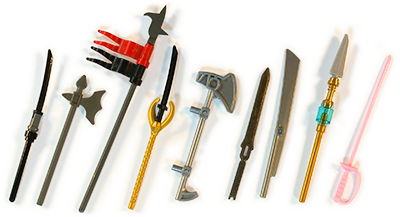

Winged Celestials and Daemons prefer the kinds of massive Two-Handed Weapons they can swing from the heavens in a mighty chop.

Two-Handed Weapons give heavy troops the power to destroy the sturdiest armored foe, and the ability to strike at targets normally out of reach - behind a rank of other minifigs, on separate building levels, or on horseback. The drawback is that Two-Handed Weapons can be difficult to maneuver and wield effectively. Minifigs carrying a Two-Handed Weapon have a hard time navigating tight spaces, and they need both hands free to use the weapon in Close Combat. (Players don't have to pose the minifig with both hands physically holding the weapon shaft. It's understood that at the moment of attack, both hands come together so quickly to swing the weapon that the eyesight of Humans is unable to detect it.) A Two-Handed Weapon's extra inches of reach carry their own vulnerability - an enemy minifig can sneak up closer than the weapon's minimum effective range. When Striking, a minifig swinging a Two-Handed Weapon must have one hand on the bottom-most grippable part of the handle. This may mean that he doesn't have enough space to bring the weapon's striking surface into contact with the target. If the minifig is unable to back up far enough to give himself room to swing, then enemies inside that distance can only be Shoved, not Struck (5.2: Close Combat). There is one important exception to the Two-Handed Weapon's two-hands requirement: Jousting, decribed in H.3: Fighting From Horseback. A minifig riding a steed or vehicle only needs one hand to use a Two-Handed Weapon as a lance in a Charge attack, as long as it has a pointy tip. Jousting minifigs can use their second hand to wield a Short-sized weapon, Shield, or equipment item.
Any minifig who takes damage from a hit with a Two-Handed Weapon is pushed one inch directly away from the attacker, regardless of whether the damage kills him. Unless he successfully Parries the hit, he is Disrupted as a result (4.1: Movement). 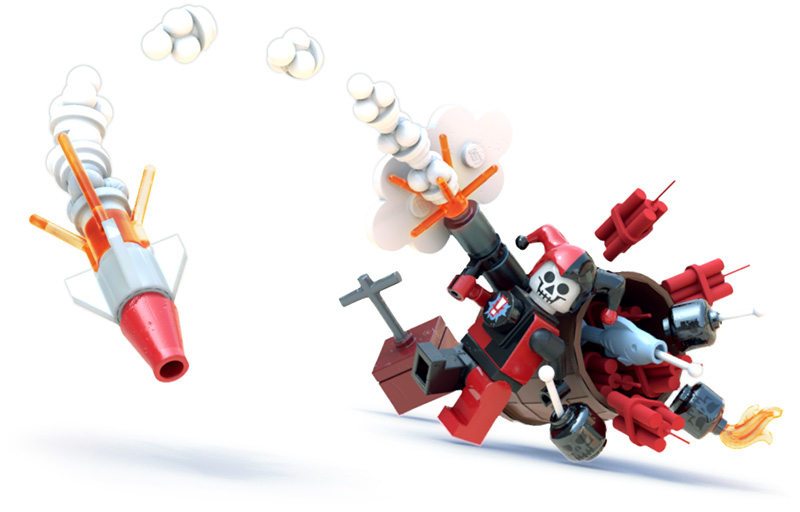
Statistically speaking, the number of things that can go wrong while carrying around this many unstable explosives is exactly zero.
"A Spirit of Tragoedia" by Bolicob
image rights: Bolicob, signed 7/23/20 Uploaded, final
It's hard to beat the joy of plunging a hand weapon into exposed enemy flesh (although not impossible, thanks to the existence of Explosives). But it can be frustrating when some jokester thinks it's funny to keep bouncing around just out of reach of a minifig's hand axe. It's times like this that a minifig wants a nice ranged sidearm, to wipe the enemy grin off the enemy face in the most literal fashion (5.3: Ranged Combat). While a Close Combat weapon's Damage is determined by the strength of the minifig swinging it, the Damage rating of a Ranged weapon isn't affected by a minifig's Action Die. A rifle fires a bullet with the same amount of force regardless of whether it's fired by a musclebound action hero or a suspiciously well-armed infant.
Short-Ranged Weapon:
Use:3
Range:6"
Damage:

The Gunslinger stays in the back of the fray, taking pot shots while her melee-focused comrades rush into Close Combat.



Most light ranged weapons fall under the Short-Ranged Weapons heading: revolvers, shortbows, blowguns, magic wands, and slings are good examples. Most can be fired with one hand; common sense should be enough to spot any exceptions (a light crossbow can be fired with one hand, for instance, while shortbows and slingshots take two). Like Hand Weapons, Short-Ranged Weapons can be paired with a second Short-sized item or a Heavy Shield. Because their limited range puts minifigs dangerously close to an enemy's ability to counterattack, Short-Ranged Weapons are often paired with a Hand Weapon in the opposite hand, or paired with a second Short-Ranged Weapon and used in hit-and-run harrying attacks that keep the Ranged attackers just out of enemies' reach.
Long-Ranged Weapon:
Use:3
Range:10"
Damage:



Long-Ranged Weapons are higher-powered than regular Ranged Weapons, allowing minifigs to pack a solid punch while staying out of enemy units' immediate melee range. Muskets, longbows, heavy crossbows, and a Magic Staff of Glitter Bolts are all Long-Range Weapons. Long-Range Weapons are generally about the length of a minifig, and always require two hands.
Explosive:
Use:2
Range:CC or 3"
Damage:
Notes: affects all targets within 2";
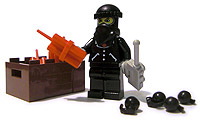 Three inches isn't a whole lot of Range, especially when it comes to throwing dynamite and grenades. Minifigs who rely on thrown weapons will want to familiarize themselves with the rules for making attacks Out of Range (5.1: Making Attacks).
Elements shown: LEGO, Brickarms 

Hand-held Explosives come in a variety of forms for a variety of purposes - grenades for throwing, rockets for firing, and timed charges for dropping somewhere and getting the hell away. A minifig's Explosive can do any of the above. If he throws it, it's a grenade; if he fires it from a launcher (launchers are bought as special-purpose Short-Ranged or Long-Ranged Weapons), it's a rocket. If he drops it on the ground and says "I'm setting the fuse to go off on the end of my next turn," then it's a timed charge; if he attaches it to an enemy vending machine and says "I'm setting the fuse to go off when I hit the button on this transmitter", then it's a remote detonator. Once they go off, though, all Explosives work the same way. The Explosive destroys itself in an Explosion, doing 1 This can often include the minifig using the Explosive, if he fails to throw it far enough or uses it as a Close Combat weapon. Any successful Strike or Counterstrike with an Explosive sets it off.
 These Yellow bullies learn to regret picking on innocent Peaches when RoC shows up with a missile launcher.
no sign of roc77
Objects damaged by an Explosion are subject to KnockBack. Any loose objects, such as minifigs not wearing seatbelts, are pushed one inch directly away from the center of the Explosion. Fixed objects, such as brick walls, are only Knocked Back if the damage breaks them into loose objects first. Minifigs who are Knocked Back are Disrupted (4.1: Movement). If a loose object is Knocked Back into a larger object that blocks it from moving the full inch, it takes an extra +1 point of Smash damage in addition to the Explosive damage. Several effects introduced in later chapters also cause inches of KnockBack, including Shoves, Collisions, and strikes with large weapons. These can cause many inches of KnockBack in a single blow, potentially causing multiple points of Smash damage if multiple inches of KnockBack are blocked. Smash damage is always cumulative with whatever damage caused the KnockBack originally. KnockBack is an introductory form of Thrust, which is covered in more detail in 9.3: Thrust Vectors. Each Explosive can only be used once, for obvious reasons. A minifig's job is to do damage and kill enemies, not to worry about coming home alive afterwards. A good leader knows that the best defense is a good offense, and a budget surplus should always be spent on more weapons and more men rather than on protective gear. The mere presence of defensive equipment casts doubt on the soldiers' eagerness to throw away their lives meaninglessly for their Human's entertainment. The cowards who request extra protection are likely to be among the least popular units, so it's good to buy them some. The longer they stay alive, the angrier the other minifigs will be, and that's a good state of mind for battle. When damage strikes a minifig wearing Heavy Armor, or one who successfully Parries with a Shield, he has Deflection against the blow. Deflection removes one Damage die from each source of damage, canceling it before it's rolled. For damage with multiple die types, Deflection removes one of each type of die, except for
By wearing Heavy Armor and successfully Parrying an attack at the same time, the most spineless minifigs of all can have Deflection twice, removing two dice from the attack's damage.
Light Shield:
Use:2
Range:CC
Effect:
Heavy Shield:
Use:3
Range:CC
Effect:
Notes: provides cover
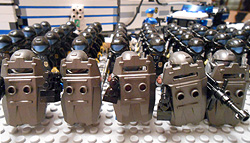 The Police State of Venice's riot squad, called "The Brick Wall," are perfect for defending chokepoints and covering backwards-advances.
Photo: Scratch From "Police State of Venice OVERHAUL 2014" Elements shown: LEGO, BrickWarriors, BrickForge image rights: Scratch, signed 12/9/20 Uploaded, final


A Shield is a tool for Parrying damage (5.2: Close Combat). A Shield is primarily intended for Parrying Close Combat attacks, but it can Parry any incoming damage in its bearer's field of view. Minifigs treat all these sources of damage as if they were Close Combat attacks for the purpose of Parrying with a Shield. 

Shields come in two sizes: regular Short-sized Light Shields, and Minifig-sized Heavy Shields. The Heavy Shield is slightly more difficult to use, with a Use of 3 rather than 2, but it has an advantage: in addition to being used to actively Parry, the Heavy Shield can also be positioned as passive cover, either by itself, in conjunction with other cover elements on the field, or arranged together with the Heavy Shields of allied units (5.1: Making Attacks). Like any passive cover, its effectiveness depends on how it's positioned between the minifig and any attackers. If it's pointed in the wrong direction when the attack is made, it's too late to reposition it.
Light Armor:
Effect:Armor +2
Notes: wearer can't swim
Heavy Armor:
Effect:
Notes:
wearer can't swim
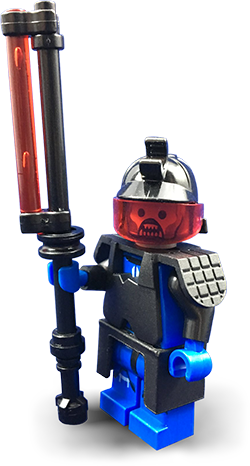
One of the original recruits of the Supreme Rida, Kiru is a legendary warrior among the ranks of the Ugokanai.
For faint-hearted warriors who fear death but are also too lazy to lift a Shield in their own defense, Body Armor is a great way to prolong their cowardly lives. 

A minifig wearing Light Armor gets +2 to Armor against all incoming damage (but not for internal damage, like the effects of having been Poisoned or the heartbreak of firing a whole battery of surface-to-air missiles and missing). Wearing Light Armor prevents a minifig from swimming. 

When a piece of Light Armor is combined with a visored helmet, it becomes Heavy Armor. A minifig wearing Heavy Armor is even better protected, but has a harder time moving around - a bonus for cowards who want to always "coincidentally" be the last to arrive at the front lines. A minifig in Heavy Armor has Deflection against all incoming damage, but is forced to move at Half Speed (4.1: Movement ). If a minifig wearing Body Armor falls in water, he must either use his Action to remove the armor or hope that someone can fish him out in a hurry. Otherwise, he will die of drowning at the end of his next turn. (Assuming he needs to breathe, that is — non-living minifigs like androids and skeletons can continue wandering around happily underwater with no ill effect.) Because of their poor mobility on foot, it's good to mount Heavy Armored minifigs on the back of a Horse (Chapter H: The Horse), or to post them in narrow gates and walkways where they can't be easily outmaneuvered and avoided. 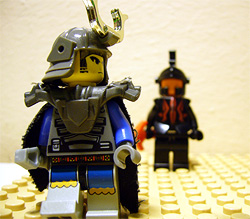 Lord Karetsu's armor awakens the demon curse haunting him since his crimes against Tikoskum.
no sign of karetsu

Despite the hypnotizing power of minifig butts, mooning the enemy has not been shown to have any practical effect.
Wiki entry: Yellow own illustration Uploaded, final
 Unable to reach the enemy wizard in time to interrupt a deadly spell, Eric Joslin's giant starts hurling the projectiles closest at hand: a flock of sheep.
Photo: Eric Joslin from "NELUG Gets Medieval" image quality too low
Nothing makes a warrior feel dumber than arriving at a battle and realizing he forgot to bring any weapons. Until he's able to scavenge an unattended weapon from the battlefield, his options are limited.
Bare Hands:
Use:0
Range:CC
Effect: Grab or
Notes:Automatic Hit unless Parried

A minifig lacks the ability to clench his clawlike hands into fists, and the rigid nature of minifig legs means that the groins of his enemies will never be exposed to his nonexistent knees. As a result, unarmed combat between minifigs is an almost complete waste of time. The only worthwhile use for Bare Hands is to grab a dropped weapon in order to not have Bare Hands anymore. Bare Hands cannot be used to Strike in Close Combat. If a minifig has at least one hand free, he can use it to Grab his opponent, either for the sake of hitting him with a weapon in his other hand later, or to hold the enemy in place for one of his better-armed allies. If both hands are empty, then the minifig can use them to Shove enemy minifigs, causing 2" of KnockBack and Disrupting them in an attempt to put some distance between himself and the real warriors who remembered to come armed. Bare Hands cannot be used to Parry a Close Combat Strike. They can be used to Parry a Shove or Grab. Strikes, Shoves, and Grabs are examples of Close Combat maneuvers, described in 5.2: Close Combat.
Minifig Tool:
Use:3
Range:CC
Damage:
 When the Elven army arrives to crush a tavern full of Frostborne and Norsemen, this brave tavern patron takes up a bottle to defend what's really important.
image rights: Kommander Ken, signed 7/23/20 Uploaded, final
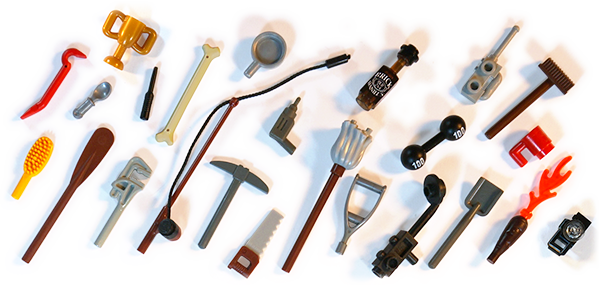

The official purpose of a Minifig Tool is to help minifigs do their jobs. Mediks need their first aid kits, Mechaniks need their wrenches, and Cleriks need their holy symbols. Fortunately for everyone involved, all of these things can also be used to beat people to death. Any tool designed to be gripped and carried in a minifig's hand can be used as a makeshift Hand Weapon with less effective stats. This includes not only obvious striking implements like hammers, torches, and frying pans, but also suitcases, coffee mugs, megaphones, and teapots. Larger Minifig-Sized Tools have the same stats but require two hands; these include rifle butts, shovels, metal detectors, push brooms, and oars. Decapitated heads and skulls also count as Minifig Tools when used in combat. Not because this makes any sense, but because beating opponents to death with their friends' faces is Ossum.
Random Object:
Use:4
Range:CC
Damage:
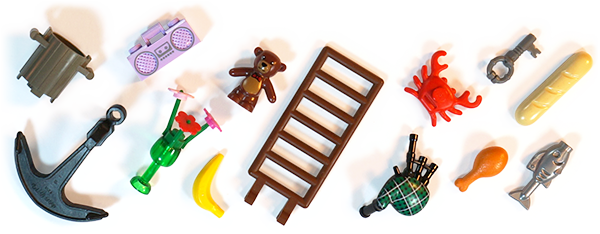

In the Human world, table legs, broken bottles, and sufficiently large rocks are all part of a cherished tradition of improvised weaponry. In BrikWars, minifigs are just as likely to improvise with a broken fender, a door, or an unsuspecting cat. If a minifig can't find a real weapon, Random Objects are better than nothing, but that's mostly because having nothing sucks to such an impressive degree. Most objects that can be picked up and swung around by a minifig can be used as improvised weapons. Some objects are excluded: items like flowers, hats, and shortbows are too flimsy to do any damage, while objects larger than two minifigs in Size are too big to pick up. A Random Object must be a physical object. A minifig can't claim "there's a belt printed on my torso, I'm taking it off and whacking you with it."
Thrown Object:
Use:*
Range:3"
Damage:*
Notes: * use Close Combat stats
 Haircules demonstrates an innovative use of thrown boulders to catch fish. And, occasionally, TechnoVikings.
image rights: Bragallot, signed 1/13/21 Uploaded, final


If an object can be used one-handed in Close Combat (whether as a regular weapon, Minifig Tool, or Random Object), it can also be thrown. A Thrown Object has the same Use and Damage rating as if it were being used in Close Combat, but with a Range of 3" it can be hurled at targets out of immediate reach. By throwing a weapon rather than running in swinging, minifigs can avoid getting pinned down in Close Combat. Once they're thrown, Thrown Objects have a known drawback in that surviving opponents can pick them up and use them against the original thrower. Grenades are a popular workaround for this issue. | ||||||||||||||||||||||||||||||||||||||||||||||||||||||||||||||||||||||||||||||||||||||||||||||||||||||||||||||||||||||||||||||||||||||||||||||||||||||||||||||||||||||